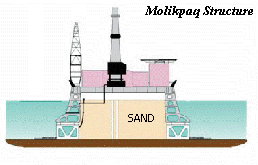 |
|
|
|
 Explosive
compaction is carried out by setting off explosive charges in the
ground. The energy released causes liquefaction of the soil close to the
blast point and causes cyclic straining of the soil. This cyclic strain
process increases pore water pressures and provided strain amplitudes
and numbers of cycles of straining are sufficient, the soil mass
liquefies (i.e. pore water pressures are temporarily elevated to the
effective vertical overburden stress in the soil mass so that a heavy
fluid is created). Liquefaction of the soil followed by time-dependent
dissipation of the water pressures causes re-consolidation within the
soil mass. This re-consolidation happens within hours to days following
blasting, depending on the permeability of the subsoils and drainage
boundary conditions, and is reflected by release of large volumes of
water at the ground surface or up blast casings. "Short term" volume
change is also caused by passage of the blast-induced shock front
through the soil mass. At close distances from a charge detonation, the
hydrodynamic pressures are large enough to cause compression of the
soil-water system even though the bulk compressibility
of the system is relatively small. Explosive
compaction is carried out by setting off explosive charges in the
ground. The energy released causes liquefaction of the soil close to the
blast point and causes cyclic straining of the soil. This cyclic strain
process increases pore water pressures and provided strain amplitudes
and numbers of cycles of straining are sufficient, the soil mass
liquefies (i.e. pore water pressures are temporarily elevated to the
effective vertical overburden stress in the soil mass so that a heavy
fluid is created). Liquefaction of the soil followed by time-dependent
dissipation of the water pressures causes re-consolidation within the
soil mass. This re-consolidation happens within hours to days following
blasting, depending on the permeability of the subsoils and drainage
boundary conditions, and is reflected by release of large volumes of
water at the ground surface or up blast casings. "Short term" volume
change is also caused by passage of the blast-induced shock front
through the soil mass. At close distances from a charge detonation, the
hydrodynamic pressures are large enough to cause compression of the
soil-water system even though the bulk compressibility
of the system is relatively small. Once an area of ground has been treated and pore pressures have largely dissipated, repeated applications ("passes") of shaking caused by controlled blast sequences (video (9113 kb)) causes additional settlement depending on soil density and stiffness. The first pass destroys any bonds existing between cohesionless soil particles due to aging and other geologic processes, and causes the majority of settlement within the soil mass. Subsequent passes cause additional settlement by cyclic straining. As a result, surface settlement and increased soil resistance to cyclic loading will be caused by the blasting. Experience has indicated that the degree of ground improvement obtained by blasting depends on the initial density of the granular subsoils. The density of loose deposits can typically increase considerably to relative densities in the range of 70 to 80%, whereas soils with initial relative densities of 60 to 70% can only be densified by a small amount. Our experience also indicates that EC generally causes volume changes equal to or in excess of what would be anticipated under design levels of earthquake shaking, as described in the attached reference paper by Gohl et al (2000). |
| Home | Contact Us | |